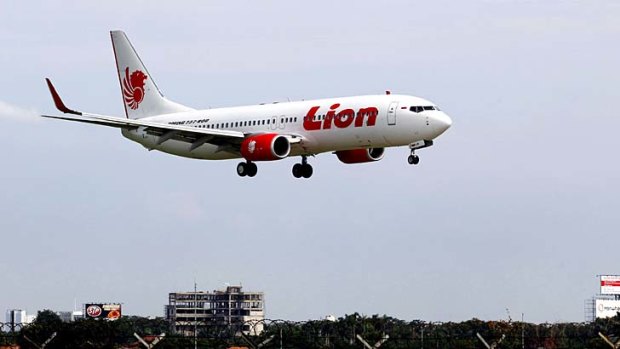
Flying high ... Indonesia's Lion Air is growing rapidly.Credit: Reuters
Indonesia’s biggest domestic airline, Lion Air, plans to take advantage of Australia’s ultra-liberal aviation rules that allow any foreign company the right to set up a domestic airline Down Under, as Singapore’s Tiger Airways did in 2007.
That ambition was mentioned again last week when Lion announced the biggest aircraft order in the history of European plane-maker Airbus, following the biggest order in US manufacturer Boeing’s history in 2012. The Indonesian behemoth wants to grow so quickly over the next decade that all its needs can’t be met by only one of the Big Two in airliner production.
Lion Air’s growth plans are anything but fanciful. In a nation of 240 million people, the domestic airline business is already the same size as Australia’s after a decade of explosive growth. Yet, according to the statistics, only about six per cent of the Indonesian population have ever flown, whereas in Australia, every man, woman and child on average travels by air more than once a year.
One of the ways Lion Air plans to grow is by copying the strategy of Asia’s biggest low-cost carrier, Malaysia’s AirAsia, which has already set up subsidiaries in Indonesia, Thailand and Japan. Owner and co-founder Rusdi Kirana not only has plans for a new Indonesian airline – a full-service carrier called Batik Air on top of the existing no-frills Lion Air, which has 45-50 per cent of the domestic market, while national carrier Garuda has only about 25 per cent – he has announced a new Malaysia-based venture called Malindo Airways.
Kirana was also the first Indonesian entrepreneur to express an interest in setting up an Australian domestic operation. In 2008, he entered a 49-per-cent-owned Australian venture with Brisbane-based charter airline SkyAirWorld. The intention was to fly Australian domestic routes and link Australian cities with Indonesia. But the venture was abandoned when SkyAirWorld collapsed in March 2009.
Lately, Kirana hasn’t been talking about his dreams of an international expansion beyond a smattering of regional destinations and regular services from Jakarta to Jeddah, Saudi Arabia, using a couple of Boeing 747-400s.
But even if he plans to exhume his long-held Australian ambitions, there is a major obstacle: Lion Air remains on a blacklist of airlines that are banned from using both European and US airspace because they haven’t passed the required internationally recognised safety audit.
The past two decades have not only seen an explosion in the number of Indonesians using airlines to get around the archipelago, but an explosion in the number of air crashes as the Indonesian government regulator struggled to maintain an adequate oversight of the local airline business.
Since it arrived on the scene in 2000 – the same year as Virgin Australia was born – Lion Air has destroyed or badly damaged no fewer than five airliners in a series of crashes and incidents. One of the crashes killed 25 people.
Garuda has been able to maintain services to Australia with the consent of the Australian regulator, the Civil Aviation Safety Authority, even during a period after the turn of the century when Garuda was on the European Union’s list of banned airlines. A second local operator, Indonesia AirAsia, is among a handful of Indonesian carriers that have won EU safety approval.
It has been reported that, as part of Lion Air’s massive new deal with Airbus to acquire more than 230 new planes, the European plane maker will send its own safety experts to Jakarta to get Lion Air’s operational standards up to scratch so that it can continue its international expansion without impediment.
But, in a country like Australia, which has been able to maintain a fatality-free record for airliner operations in the jet age (even though there have been a number of fatal turbo-prop and piston-engine airliner accidents since World War Two), I think the idea of an Indonesian operator with a poor safety record successfully setting up shop in Australia in the next decade is a long shot.
Would you fly with Lion Air if they began operating on Australian routes? Have you flown with them in Indonesia? What was the experience like? Would you welcome an opening up of new air routes between Australia and Indonesia? Post your comments below.
Sign up for the Traveller Deals newsletter
Get exclusive travel deals delivered straight to your inbox. Sign up now.